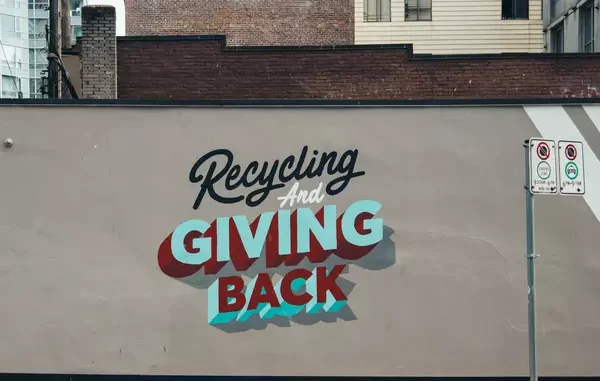
When you consider your household carbon footprint, recycling your waste has a positive impact on your overall carbon footprint. However, it is probably a very small piece of your carbon footprint. Think about it like the pinky toe on a big old hairy foot. Or possibly a toe nail.
Let’s walk through the typical household and where the majority of their carbon comes from, focusing on heating, electricity, transportation, and household waste.
The Carbon Footprint of Mr. Average, Averageville, U.S.A.
We need to come up with an estimate of the carbon footprint of the average U.S. household. It is easy to come up with the overall average, according to the World in Data it is about 14 tons per person in the U.S.
But that is too easy. For fun, we found the most average place in the U.S. and ran it through EPA’s Carbon Footprint Calculator.
Evidently, the most average place in the U.S. is in Lynchburg Virginia. We will also rely on Statista’s average household size of 3 people (rounded down).
When you estimate Mr. Average’s carbon footprint using the EPA’s carbon footprint calculator, you can easily see the big sources of carbon in Mr. Average’s life.
Gas and Electricity’s Carbon Footprint

The EPA’s calculator starts with heating and electricity.
The Department of Energy’s Energy Information Administration (EIA) provides the average electricity usage from 2019. U.S. households used an average of 887 kilowatt hours per month in 2019.
EIA is a wonderful source of energy data but they do not provide the average natural gas usage in the U.S. for households. But EPA’s calculator says the average for a 3 person household is about $69 in gas usage per month.
Burning natural gas is the most common way Americans heat their homes.
Mr. Average already produced 25,000 pounds of carbon dioxide annually and he hasn’t even gotten in his car yet!
Transportation and Carbon Emissions
Unless you drive an electric vehicle, then you are emitting emissions from your tailpipe. Transportation represents 27 percent of U.S. emissions.
The average household in the U.S. owns 1.88 vehicles, but we will round that up to 2.
It was hard to find the average miles driven per household. The average vehicle owner drives about 14,000 miles a year. However, since Mr. Average has two vehicles, probably one for his lovely partner, Mr. or Mrs. Average, they drive more than the per capita average.
The Department of Energy reports that people drive the average vehicle about 10,000 miles per year. We will assign Mr. Average’s house 20,000 miles driven per year.
Since Americans love SUVs, we reached a new high for average fuel economy in 2020 of about 26 miles per gallon. America, fuck yeah! (sigh).
Mr. Average’s transportation related carbon emissions come in at 15,000 pounds of carbon dioxide.
Mr. Average’s Recycling Rate is Relatively Unimportant
What if Mr. Average, lazy bum that he is, tosses all of his aluminum cans, cardboard, and recyclables into the trash instead of the recycling bin? Actually, it makes a relatively small difference for his carbon footprint.
In fact, tossing all his recycling into the trash only adds one more ton of carbon dioxide to the Earth’s atmosphere.
If he decides to take that extra step and recycle, he’ll reduce his household emissions by 870 pounds. Mr. Average would reduce his total household emissions from trash to a total of 1200 pounds of carbon emissions.
In terms of his overall carbon footprint, choosing to recycle would only reduce his carbon footprint by well under 1%.
In Defense of Recycling and Recycled Products
If you read some of our other blog posts, like our deep dive into the darker side of recycling, you might begin to wonder why a blog purportedly focused on recycling “talks trash” on recycling so much. Don’t get the wrong idea, we love recycling, it is far superior to burying waste materials in hermetically sealed landfills.
But we also believe, as discussed in our blog post above, that recycling can be used as a distraction, or even a subtle excuse, to live the profligate consumerist lifestyle and assume all is good.
The truth is, recycling is the last step in the life of a product or whatever material thing we are talking about. Often, much of the carbon footprint of a thing is already baked into it by the time you purchase it.
Think about it, before you buy that new, beautiful, absolutely essential “thingy,” the company needs to do a whole bunch of things. They need the materials, which will likely involve extracting the material from the Earth, such as cutting down trees or mining material from the bowels of the Earth. They will need to transport that material across the planet. Refine the material, ship that across to another part of the planet, etc. You get the idea.
However, our silly experiment above with Mr. Average only captures that last step in the product’s life. We do not capture the benefit of buying things made from recycled content.
Buying Recycled Products Reduces Emissions

When companies use recycled material, they can skip over most of the carbon-intensive steps in the life of a product. We have highlighted some of the false promises of the circular economy in our post about textile waste, but if we move to a more circular process, we do reduce emissions.
The UN Intergovernmental Panel on Climate Change, better known as the IPCC, talks about moving towards a more circular or closed-loop manufacturing process versus the “extract-produce-use-discard” model.
Take the lowly aluminum can, which is highly recyclable. If using recycled aluminum, a company can skip extracting aluminum from deep within the planet. Skip firing up huge Tolkien-esque smelting equipment to liquify the ore. Skip shipping raw materials.
In fact, using recycled aluminum reduces the energy used by 95%!
The IPCC specifically highlights this example. They point out that recycling is really about the upfront savings, which they refer to resource efficiency (as opposed to energy efficiency).
The IPCC reports that increasing the use of recycled metals, steel and aluminum, could cut energy usage in those sectors by half in the next forty years.
It isn’t just recycled aluminum though, as we highlighted in our screed about how bad plastic water bottles are for the environment, researchers also found that most of the emissions of plastic bottles is upfront in extraction of virgin material and manufacturing.
Buying Recycled Products Sends A Message to Companies
Buying recycling content products helps send a signal to companies that using virgin materials is not what people want.
The more people demand recycled products, the more companies will buy recycled materials, sucking up our trash and reusing it. The more companies demand recycled materials, your discarded cardboard boxes and old soda cans will be worth in the market, driving recyclers to collect more from the waste stream. It is a virtuous cycle.
Though the last step in the recycling process, tossing it in the recycling can does not by itself reduce emissions much. Without that last incremental step of putting your recycle material in the recycling bin, you neglect to close the circle of the so-called circular economy.
So keep recycling, but don’t obsess over it. If you really want to fight climate change, also look at your larger carbon footprint – your electricity, heating, and transportation. You will find the big chunks of your emissions in those areas of your life.